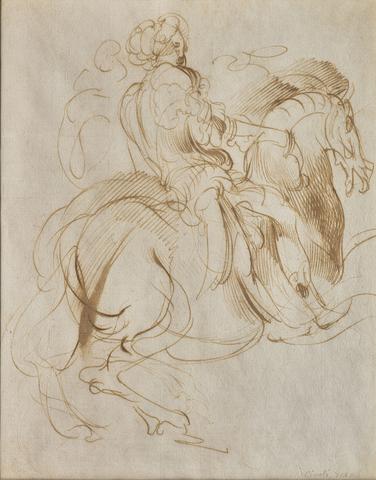
Cavalier
Jacques Bellange (attribué à) (vers 1575 Bassigny - 1616 Nancy)
1600 (vers)
Plume et encre brune, lavis brun ; annoté « Cigoli » en bas à droite ; filigrane ; 24,5 x 19 cm
Provenance :
Paris, galerie de Bayser (en 1990) ; Ile-de-France, collection privée ; Paris, Artcurial, 14 novembre 2017 (Georges Lallemant).
Le graphisme suprêmement libre et volontaire de ce dessin – par ailleurs dans un état de conservation remarquable – appelle le nom d’un maître, et nous proposons celui de Bellange, plutôt que son contemporain Lallemant, moins audacieux, plus raide, on dirait aujourd’hui « coincé », dont les chevaux ont un peu l’air de chevaux de manège forain, ce qui n’est certes pas le cas ici.
Alors que Lallemant s’établit à Paris dès 1601, Bellange devient en 1603 peintre à la cour de Charles III de Lorraine à Nancy, alors l’une des plus raffinées d’Europe. Entre la fin des guerres de Religion (1598), côté français, et le début de la guerre de Trente Ans (1618), côté germanique, la Lorraine indépendante connaît un moment de paix relative et de prospérité. Son art est en lien avec l’École de Fontainebleau comme avec l’École de Prague, et la Toscane, la fille de Charles III Christine de Lorraine ayant épousé le Grand-Duc Ferdinand I de Médicis (1589). D’où peut-être l’attribution ancienne, mais insoutenable, à Cigoli.
C’est dans l’ambiance de fêtes et de tournois de la cour de Nancy qu’est né ce dessin virtuose. La fière attitude du cavalier, la tête étroite du cheval, se retrouvent dans un dessin au Musée du Louvre, collection Edmond de Rothschild (n° 1611 DR), et dans un autre au National Museum de Stockholm (n° NMH 81/1874:89). La coiffe, ou coiffure, « boursouflée » est typique aussi, pour ne pas dire un tic, de Bellange.
Quant au trait vif et fin d’encre brune, moins fréquent que les lavis vaporeux auxquels on associe souvent Bellange, il rappelle celui de la Femme assise, de profil au Musée de l’Ermitage (n° OP 16124).
